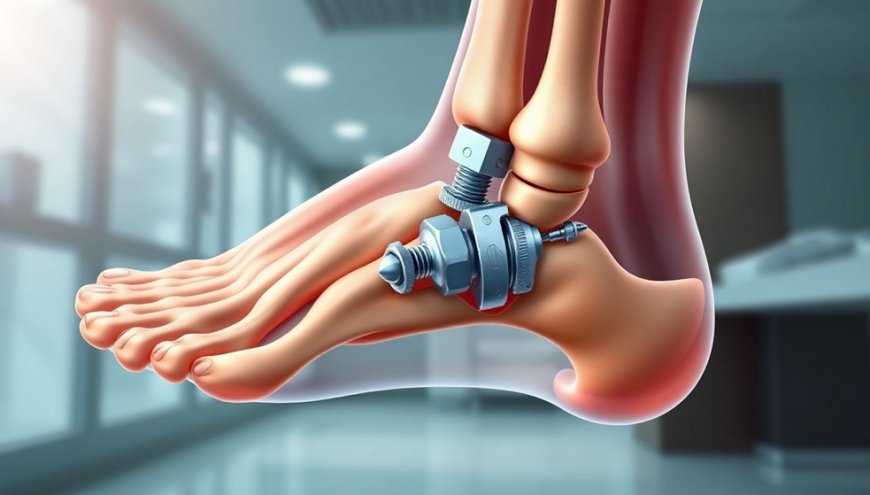Ankle Fusion Pros and Cons: A Complete Guide to Making the Right Decision
Ankle fusion relieves chronic pain and improves stability but limits joint motion. This guide highlights its key pros, cons, and decision factors.

Chronic ankle pain can significantly impact your ability to move, work, or enjoy daily life. Whether caused by arthritis, past injuries, or deformities, severe ankle damage sometimes leads doctors to recommend a surgical option known as ankle fusion. Like any medical procedure, this surgery has both advantages and drawbacks and understanding the Ankle Fusion Pros and Cons is essential before deciding if it's right for you.
This guide breaks down the key benefits, risks, and factors to consider, helping patients and caregivers make confident, informed choices about this widely used treatment.
What Is Ankle Fusion?
Ankle fusion, medically referred to as ankle arthrodesis, is a surgical procedure where the bones in the ankle joint usually the tibia and talus are fused together. The goal is to eliminate painful motion in the joint by turning it into one solid, immobile structure. This is done by removing damaged cartilage and using screws, plates, or rods to hold the bones together until they heal as one.
Ankle fusion is typically recommended for individuals with end-stage arthritis, chronic instability, or severe trauma to the ankle that doesnt respond to conservative treatments. It's considered a permanent solution to long-standing pain and deformity.
Ankle Fusion Pros and Cons: What You Need to Know
Understanding both sides of the coin is critical when considering ankle fusion. Here's a balanced look at what you can expect.
Pros of Ankle Fusion
1. Significant Pain Relief
A major benefit of ankle fusion is a substantial reduction often elimination of joint pain. Since the joint no longer moves, the source of pain from worn cartilage or bone-on-bone contact is removed.
2. Improved Joint Stability
Fusion strengthens the ankle, especially in cases of instability caused by arthritis or ligament damage. Many patients can return to low-impact activities like walking, hiking, and standing for long periods without the fear of the ankle giving out.
3. Long-Term Durability
Unlike ankle replacement, fusion doesnt involve implants that wear out. For people with active lifestyles or high body weight, fusion is often more durable and requires fewer future surgeries.
4. Cost-Effective in the Long Run
While the initial surgery may be expensive, ankle fusion may save money over time by eliminating the need for repeat surgeries or treatments. Many find it a one-and-done solution to years of chronic ankle problems.
5. Quality of Life Improvements
For patients whose pain is so severe that it limits everyday function, fusion can be life-changing. Once healing is complete, many people find they can walk without pain and return to daily routines with greater confidence.
Cons of Ankle Fusion
1. Loss of Ankle Motion
Perhaps the most significant downside among the Ankle Fusion Pros and Cons is the permanent loss of ankle movement. Fusion means the joint no longer bends, which can lead to a noticeable change in how you walk (gait alterations). Running or high-impact sports may no longer be possible.
2. Strain on Adjacent Joints
When the ankle no longer moves, nearby joints (like the subtalar joint or the knee) take on more stress to compensate. Over time, this can lead to secondary arthritis and additional discomfort in other parts of the foot or leg.
3. Surgical Risks and Complications
As with any operation, ankle fusion comes with risks including infection, blood clots, nerve damage, or non-union, where the bones fail to fuse properly. Some patients may also develop hardware issues that require removal or revision surgery.
4. Extended Recovery Period
Recovery can take 3 to 6 months or longer. You'll need to wear a cast or boot and avoid putting weight on the ankle during the early healing stages. Physical therapy is often necessary to adjust to a new walking pattern.
5. Limited Future Flexibility
Unlike ankle replacements, which can sometimes be revised or swapped out, fusion is a permanent change. If your needs or lifestyle evolve, making adjustments later can be difficult. Thats why weighing the Ankle Fusion Pros and Cons ahead of time is critical.
Factors to Consider Before Choosing Ankle Fusion
Patient-Specific Considerations
- Age and activity level: Younger, more active patients may prefer ankle replacement to preserve motion.
- Health status: Smoking, diabetes, or poor circulation can slow healing or increase complication risks.
- Lifestyle goals: If your priority is walking without pain (vs. high mobility), fusion may be ideal.
Surgeon Experience and Technology
Success rates are higher when performed by skilled orthopedic surgeons using modern fusion techniques. Be sure to ask about your surgeons experience and the type of hardware or imaging used.
Alternatives to Ankle Fusion
Not everyone is a candidate for fusion. Depending on your case, you may want to explore:
- Total ankle replacement: Preserves motion but may wear out over time.
- Ankle debridement: Removes bone spurs or inflamed tissue.
- Bracing and physical therapy: For less advanced arthritis or joint instability.
Your orthopedic surgeon can help you compare these options in light of your long-term goals.
When chronic ankle pain makes walking difficult, ankle fusion can offer long-term relief and renewed stability. However, like any major surgery, its not without trade-offs. The Ankle Fusion Pros and Cons include clear pain relief and joint durability, but also come with permanent loss of motion and possible future stress on nearby joints.
Making the right decision means discussing your specific condition, lifestyle, and expectations with a qualified orthopedic specialist. Whether fusion is the final choice or part of a larger treatment discussion, understanding your options thoroughly is the first step toward improved mobility and quality of life.











































